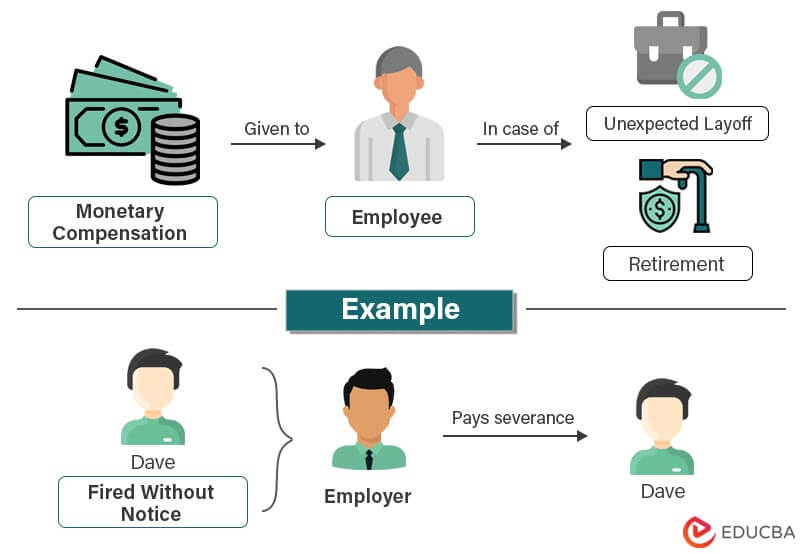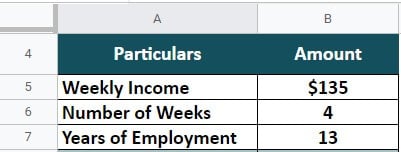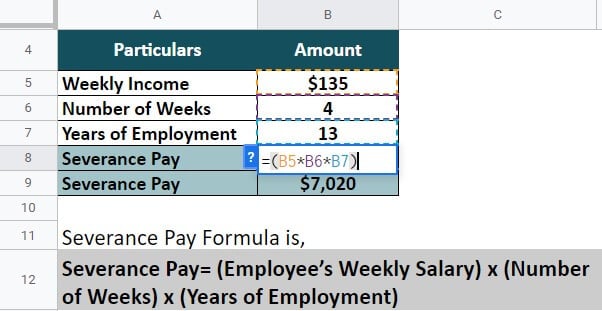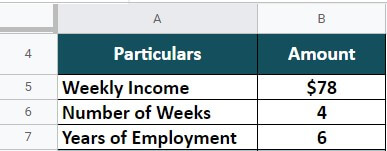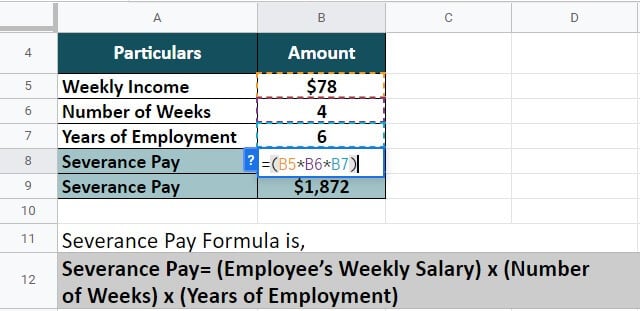Updated July 4, 2023
What is Severance Pay?
Severance pay, also known as discontinuation wage, is a financial compensation that an employer gives to an employee when they are no longer employed. An employer must provide a 30-90 day notice before firing an employee.
Thus, in case of unexpected layoffs, when a company is reducing staff or an employee is leaving their job, the employer must pay the employee a specific amount. The money helps the employee pay for living expenses while they look for a new job.
For example, a company closed one of its branch offices in 2021 due to financial losses during the Covid. It led to sixty employees losing their jobs. The company paid those employees severance pay to help them till they found their next jobs.
Key Highlights
- Severance pay is the amount an employer pays to a laid-off employee till they find another job.
- The amount depends on the person’s employment span and salary scale.
- The pay is taxable like any other income of an individual.
- Employers pay severance in case of an unexpected layoff, while termination pay is for employees leaving due to poor performance.
How Does Severance Pay Work?
The pay depends on factors like how long the employee worked for the company and their job position. Usually, employees with a longer service period and higher positions receive more severance.
Here’s an example of how it works:
1: A small company is experiencing financial difficulties and needs to lay off some employees.
2: One of the employees affected is a sales manager, so the company decided to give two weeks’ worth of pay for every year they worked for the company.
3: If the sales manager worked for the company for five years and made $500 a week, they would receive a severance pay of $5,000 ($500 x 2 weeks x 5 years).
4: The Company pays the money in a lump sum when the employee’s employment ends.
Severance Pay Formula
To calculate it, we can use the following formula:
- The employee’s weekly salary denotes the amount they used to earn per week.
- The number of weeks depends on the number of employment years.
- The number of years employed refers to the total years they have worked for the company.
For example, if an employee’s weekly salary is $80, and we consider the number of weeks counted based on their employment span to be 4, and their employment span is of 10 years, their severance pay would be:
= ($80 x 4 x 10) = $3,200
How is Severance Pay Calculated?
Here is a step-by-step process for calculating severance pay:
Step #1 Determine the length of service
It depends on the length of time an employee has worked for a company. Thus, determine the employee’s service period.
Step #2 Determine the Number of Weeks
The number of weeks counted depends on several factors, such as the employee’s employment status, employment span, and government regulations. Therefore the next step is to calculate the number of weeks.
Step #3 Calculate the Weekly Salary
Employers need to calculate the employee’s weekly salary based on their years of service, job title, and other factors.
Step #4 Calculate Additional Benefits
In some cases, employers may need to consider additional benefits that are part of the employee’s severance package, such as unused vacation days, bonuses, or stock options.
Step #5 Consider Local and Federal Laws
Employers should consult legal counsel to ensure their severance package complies with all applicable state and federal laws.
Step #6 Negotiate and Finalize the Agreement
Once the employer has determined all the factors involved, they can negotiate with the employee to agree. Once all parties have agreed on a final number, they should sign a written agreement that outlines the terms and conditions of the severance package.
Step #7 Pay out the Severance
Once all paperwork is over, employers should issue the pay following the state laws. It can either be a lump sum payment or installments over a period.
Examples
Example #1
Thomas has a weekly income of $135. He has been an employee for 13 years. We consider the number of weeks according to his employment span to be 4. Calculate his severance pay.
Given,
Solution,
Therefore, Thomas’s discontinuation wage is $7,020.
Example #2
Richard’s employer laid him off after six years of employment due to the organization’s downsizing. His weekly salary was $78. The number of weeks counted according to his employment span is 4. Calculate his severance pay.
Given,
Solution,
Therefore, Richard’s severance amounts to $1872 after his employer releases him from his job.
Is Severance Pay Taxable?
- It is a taxable income; any benefits included in the package may also be subject to taxation.
- As per the IRS, under the section of employment taxes, it is taxable under FUTA (Federal Unemployment Tax Act).
- It is also taxable under the social security and Medicare tax when the income exceeds $200,000.
- Moreover, the employer can withhold part of the income, which is taxable under withholding tax.
- Thus, a person receiving severance must pay taxes to the government according to the appropriate taxation laws.
Severance Pay in Different Situations
Retirement:
- If an employee receives the payment at retirement, the amount depends on their annual salary and employment span.
- They might receive two weeks to a month’s pay per employment year.
Army/Military:
- After retirement, army and military personnel receive a severance equal to two months of their basic salary.
- It may also include active duty and paid leaves.
Layoff/Termination:
- When fired, employees receive a payment worth one to two weeks’ salary for each employment year.
- However, there is no government regulation regarding this matter.
Effects of Severance Pay on Unemployment Benefits
The following are the effects of unemployment benefits:
- If a person’s weekly severance amount equals or exceeds 1.5 times their weekly unemployment pay, they do not receive unemployment benefits.
- The person receives the severance over time in installments instead of a lump sum. They will not receive unemployment benefits until the completion of the payment.
- If the employer allocates the lump sum payment to a certain week after they release them, their unemployment benefit of that particular week decreases.
Severance vs. Termination Pay
| Particulars | Severance Pay | Termination Pay |
| Reason Behind the Release | It applies to an employee whose employer has laid him off due to restructuring or downsizing the business. | It is for an employee whose employer terminated their service due to poor performance or misconduct. |
| Type of Payment | It may be a lump sum or a structured payment over a certain period. | It is generally a lump sum payment paid all at once. |
| Employment Period | It applies to employees with an employment span of a minimum of five years. | It applies to every employee who has worked for more than three months. |
| Condition | It applies only when the employer lays off 50 or more employees within 6 months. | It takes place after a minimum notice period of 5 weeks. |
| Inclusion | It includes payments for unused leaves, health insurance, outstation allotment, etc. | It does not have any such inclusions. |
Severance Pay Calculator
| Employee’s Weekly Salary | |
| Number of Weeks | |
| Number of Years Employed | |
| Severance Pay = | |
| Severance Pay = | Employee’s Weekly Salary x Number of Weeks * Number of Years Employed |
| = | 0 x 0 x 0 = 0 |
Frequently Asked Questions (FAQs)
Q1. Is severance pay the same as gratuity?
Answer: Severance is different from gratuity. It is the amount an employer pays their laid-off employee till he finds another job. It is a product of an employee’s weekly salary, the number of weeks counted per year, and the number of employment years. Gratuity, on the other hand, is the amount an employee receives on their retirement. It has no relation to their salary during their employment years.
Q2. Is severance calculated on basic salary?
Answer: The employer calculates the employee’s discontinuation wage based on their basic salary. It amounts to 50% of their basic salary, added to the dearness allowance they used to receive during the employment period.
Q3. What is the purpose of severance pay?
Answer: The primary purpose of severance is to provide a laid-off employee with a certain amount of money till they find their next job. It counts as a token of appreciation for their efforts and hard work throughout their employment.
Q4. How is severance pay taxed?
Answer: A person pays taxes on their severance amount in the same year they receive it. They also have to pay taxes on any payments for sick leaves or vacations. The employer includes the details in the employee’s Form W-2, which complies with all state and federal taxation laws.
Q5. When do you get severance pay?
Answer: Employees get their discontinuation wage upon release from their employment until they find their next source of income. The employment period should last for a minimum of five years. It can result from the company’s downsizing or the employee’s poor performance throughout the service period.
Recommended Articles
This was an EDUCBA guide to Severance Pay. To learn more, please refer to EDUCBA’s Recommended Articles.

